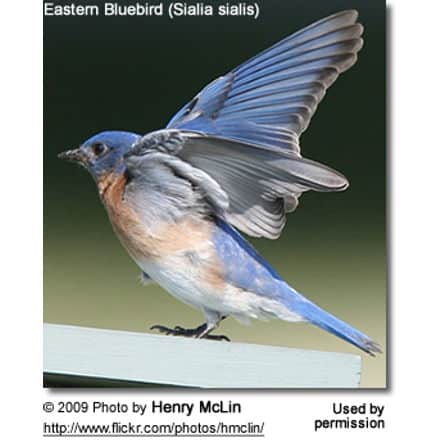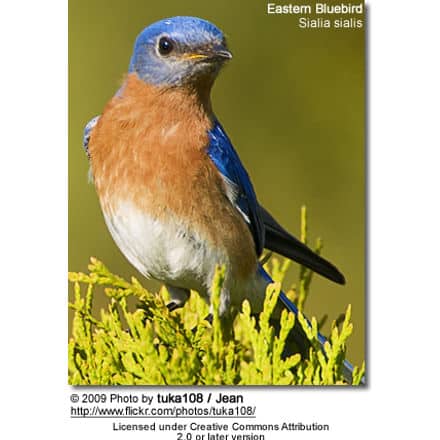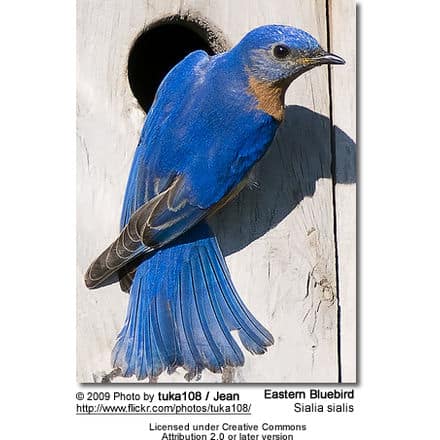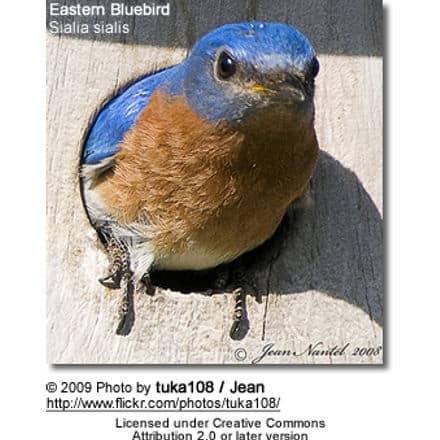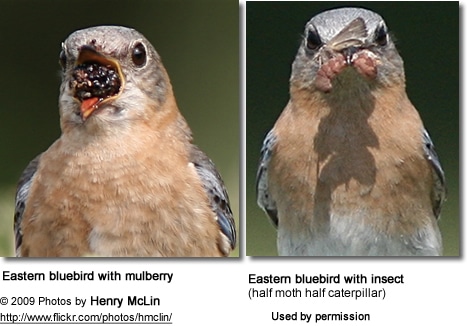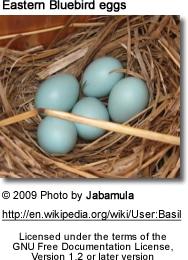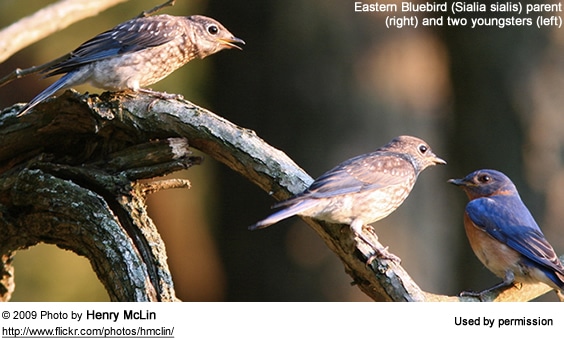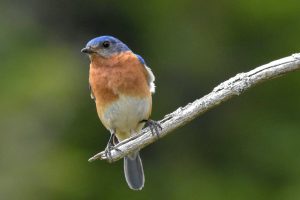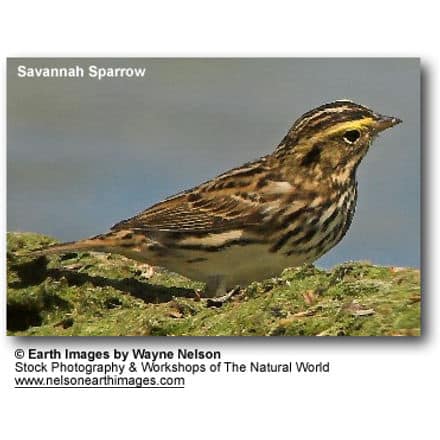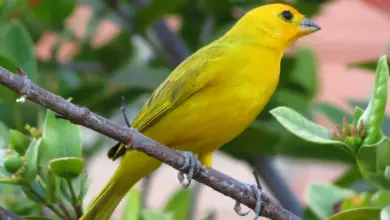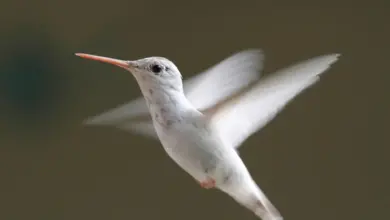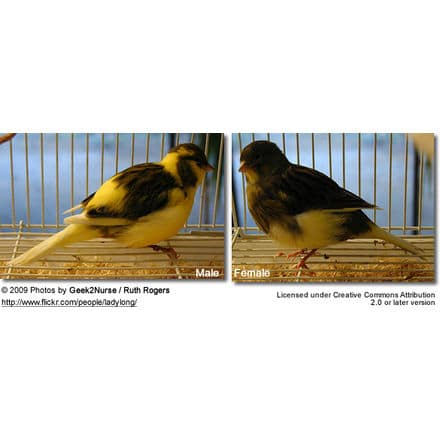Eastern Bluebirds
Eastern Bluebirds – Known as Azure Bluebirds or Blue Robins
The Eastern Bluebirds (Sialia sialis) – also regionally known as Azure Bluebirds, Common Bluebirds, or Blue Robins – are popular, well-known songbirds found across eastern North America. Their range stretches south to Nicaragua in Central America.
These beautiful little birds are readily recognized by the male’s vivid royal blue upper plumage, reddish-brown chest, and white abdomen.
Within their range, these birds are quite distinctive. The only other birds they could be confused with are their cousins – the Mountain Bluebirds (Sialia currucoides) and the Western Bluebirds (Sialia mexicana). They share similar plumage details, behavior traits, and habits. However, they occupy different ranges with only some overlap in the mid-west and central parts of the United States. The Eastern Bluebirds occasionally hybridize with Mountain Bluebirds in areas where their ranges meet.
During the migration – or at their wintering sites – these social birds may gather in mixed-species flocks of a hundred birds or more that may include – at least in part of their range – Yellow-rumped, Palm and Pine Warblers as well as Dark-eyed Juncos. However, during the breeding season, they tend to aggressively defend breeding and feeding territories. During the winter, they are also known to attack birds entering their favorite feeding areas.
Interesting Facts about Eastern Bluebirds:
- The Eastern Bluebird is the official State Bird of Missouri and New York, USA.
- Bluebird houses and their impact on conservation: The species are favorites for bird watchers and even though these insect-feeding birds will not generally use bird feeders, they do readily accept man-made nest boxes. In the 1930s, the numbers of these
delightful little birds declined at an alarming rate due to a combination of competition for nesting sites with other birds, the use of pesticides, and the loss of suitable habitat. However, artificial birdhouses have helped reverse the decline.
- When faced by predators, Eastern Bluebirds will flick their wings and warble. Males emit song-like warning cries.
- Migration and Flying Speeds: Bluebirds found in the northern part of their range are migratory – breeding in the north and moving south for the winter. Some populations breeding in Canada migrate as far as 2,000 miles to their wintering grounds. These bluebirds have been measured at flying speeds of 17 miles per hour.
- Bluebird Mythology: Navajo Indians considered these birds sacred because of their sky-blue plumages, and they included Bluebird songs amongst their tribal music traditions. Many tribes consider these birds symbols of spring and happiness, love and hope. The Cherokees associated Bluebirds with the wind and believed that these birds could predict or possibly control the weather. Historically, spotting a Bluebird was believed to be a lucky sign.
Distribution / Habitat
Eastern Bluebirds are fairly common in southern Canada and the eastern three-fifths of the lower 48 states of the USA (east of the Rockies).
They are rare and uncommon in southeastern Arizona, and vagrants in Alberta, Canada, and Utah, USA. They have recently reported in western Colorado. They have also been seen in Cuba.
From the US, their range stretches south through Mexico to Nicaragua in Central America.
They inhabit open woodlands, fields, pastures, and orchards, and have also adapted to living in suburban settings, including parks and gardens. They prefer open areas with scattered trees for perching, nesting, and feeding.
Those birds found in southern parts of their range are often resident (non-migratory), except possibly traveling short distances. On the other hand, northern populations are entirely migratory and typically travel in flocks to and from their winter territories in the central and southern United States and northeastern Mexico. Spring migration takes place between February to April, and most return to their winter range when temperatures drop and food sources become scarce (around October).
Subspecies, Ranges, and Physical Differences
- Eastern Bluebird (nominate) (Sialia sialis sialis – Linnaeus, 1758)
- Range: Somewhat migratory. South central and eastern Canada and eastern USA south to northeastern Mexico. Non-breeding populations are also found in northern Mexico, Bermuda, and Cuba.
- ID: Short bill
- Sialia sialis sialis [episcopus] – Proposed race. Most include them in the nominate form.
- Southern coastal Texas (Rockport) to southern Tamaulipas in north-eastern Mexico
- Mexican Eastern Bluebird (Sialia sialis fulva – Brewster, 1885)
- Range: Breed in the mountains of south-central / southeastern Arizona south through montane central Mexico as far south as the Mexican state of Guerrero. Wintering territories range south to Guatemala in Central America. Resident populations exist.
- ID: Slightly larger and paler than nominate race. Males have cinnamon-fringed scapulars (“shoulders”)
- Azure Bluebird (Sialia sialis [azurea]) – Subspecies of sp. fulva, although not universally recognized.
-
- Florida Bluebird (Sialia sialis grata – Bangs, 1898)
- Range: Southern peninsular Florida
- ID: Longer bill
- Eastern Bluebird (bermudensis) (Sialia sialis bermudensis – Verrill, 1901)
- Range: Bermuda
- Florida Bluebird (Sialia sialis grata – Bangs, 1898)
- Eastern Bluebird (nidificans) (Sialia sialis nidificans – Phillips, AR, 1991)
- Range: Caribbean slope of east-central Mexico
- ID: Larger, deeper blue plumage. Feathers on the back edged with cinnamon
- Tamaulipas Bluebird / Eastern Bluebird (guatemalae) (Sialia sialis guatemalae – Ridgway, 1882)
- Range: Mountains of south-eastern Mexico (southern Tamaulipas to Chiapas) and Guatemala
- Eastern Bluebird (meridionalis) (Sialia sialis meridionalis – Dickey and van Rossem, 1930)
- Range: Mountains of El Salvador west to Honduras and south to north-eastern Nicaragu
- Eastern Bluebird (caribaea) (Sialia sialis caribaea – Howell, TR, 1965)
- Range: Eastern Honduras and northeastern Nicaragua.
Description
Size
- Medium-sized thrushes. About two-thirds the size of the American Robin.
- Length (including tail): 6.3 – 8.3 inches (16 – 21 cm)
- Wingspan: 9.8 – 12.6 inches (25 – 32 cm)
- Weight: 0.95 – 1.20 oz (27 – 34 grams)
Plumage Details / Adults
Males:
- Bright blue upper plumage
- Throat, chest, and sides range in color from orangey, reddish to reddish brown
- Pale/whitish abdomen
Females:
- Partial whitish eye rings
- Wings and tail a lighter blue
- Throat and chest brownish
- Crown and back grey
Mutations
- Several cases of albinism (white-plumaged birds) have been reported.
Other Physical Details
- Big, rounded head
- Short, straight bill
- Large eyes
- Compact body
- Long wings
- Fairly short tail and legs
Gender ID
- Females are generally larger.
- Plumage is duller with different plumage pattern
Juvenile Description
- Fledglings have a greyish plumage with a speckled chest and blue-tipped wings.
- As they grow older, the blue color becomes more prominent and the speckles on their chest disappear.
Similar Species
- Male Eastern Bluebirds can most easily be differentiated from the related Mountain Bluebirds by their pale bellies.
- Male Western Bluebirds have all blue heads and the plumage is typically a deeper blue. They also have some rufous markings on the upper plumage, in particular on the “shoulders” (scapulars).
Diet / Feeding
- During the spring and summer months, adult bluebirds mostly feed on insects and other invertebrates, including grasshoppers, crickets, caterpillars, katydids, beetles, as well as earthworms, spiders, millipedes, centipedes, sow bugs and snails. These insect-eating birds help control insect populations without the use of toxic pesticides.
- During the winter – when insects are less available – their diet is made up of wild fruit, and plants, such as blackberries, bayberries, pokeberries, honeysuckle, dogwood, red cedar, and wild grapes. They will also take seeds, grains, and nuts.
Breeding / Nesting
Eastern Bluebirds breed in the spring and summer, typically raising two broods each season in the northern portions of their range, and populations breeding further south may raise to three broods in a season. The number of broods depends on weather conditions and the availability of insect prey (food) needed to raise the young.
Males attract females by taking nesting materials to potential nesting sites and displaying them to the females to attract their attention. They will be waiving their wings while sitting perched on their chosen nest site.
As soon as a male’s efforts are successful, the female will take over and bu
ild the nest. Nests historically were tree cavities (such as abandoned woodpecker holes) or other cavities that provided adequate protection. Nowadays, artificial birdhouses are often readily accepted. Nests are usually several feet above the ground. The female constructs inside the cavity a small, cup-like structure out of stems, grasses, pine needles, and roots, and lines it with finer grasses, feathers or down, and mammal hair. The whole process usually takes her about ten days.
A clutch may consist of 2 to 7 eggs (the average being 4 to 5). The eggs range in color from white to bluish. The female alone incubates the eggs for 12 to 16 days. The hatchlings are naked, blind, and completely helpless. The female generally broods them for up to seven days until she ventures out to feed and hunt food for the young. During the initial brooding period, the male feeds both the female and the young. Once the young are old enough to be left alone, the female will help feed them. The young fledge (leave the nest) when they are about 15 to 21 days old.
The chicks require a diet rich in protein to support their rapid growth, so their diet at this stage is almost entirely made up of insects.
Once the young are independent, they may remain with their parents and help them raise another brood.
Calls / Vocalizations / Sounds / Video
Their musical calls are described as varied, with songs that sound like two-noted too-lee, chiti WEEW wewidoo, or other mellow series of warbled phrases.
The male’s calls are soft warbles of jeewthe or chir-wi.
Bluebird checking out Nest Box
Alternate (Global) Names
Chinese: ?? … Czech: Salašník modrý, Sialie horská … Danish: Østlig Sialia … Delaware: Chihopèkëlis … Dutch: Oostelijke Bluebird, Roodkeelsialia … Estonian: ida-sinilind … Finnish: Hohtosinikka … French: Merle bleu à poitrine rouge, Merle bleu d’Amérique, Merlebleu à poitrine rouge, Merlebleu de l’Est … German: Rotkehl-Hüttensänger … Hungarian: vörösbegy? kékmadár … Italian: Azzurrino orientale, Uccello azzurro orientale … Japanese: ruritsugumi … Lithuanian: Sialija … Norwegian: Østblåfugl … Polish: Blekitnik rudogardly, Modraszka rudogard?a … Russian: ?? … Slovak: Drozd modrochrbtý, salašník modrochrbtý … Spanish: Azulejo, Azulejo Garganta Canela, Azulejo Gorgicanelo, Azulejo Oriental, Azulillo de Garganta Canela, Celeste Oriental … Swedish: Östsialia
Life Cycle
Eastern Bluebirds can live 8 – 10 years. The oldest recorded bird was 10 years and 5 months old. However, most birds don’t make it through the first year due to harsh
environmental conditions during the nesting period to some extent, but primarily they fall victim to predators, such as cats, chipmunks, squirrels, raccoons, and larger birds.
Other Web Resources
- Attracting Bluebirds to your Garden
- Bluebird Information
- Photos of the Various Bluebird Species for Identification
Conservation Status and Measures
Once quite common throughout their range, the number of Eastern Bluebirds declined drastically this century – in some areas as much as 90%. This is attributed to:
- Competition for nesting cavities and food with other, more aggressive birds (such as sparrows and starlings)
- Destruction of their natural habitat: Much of its habitat has been converted into farmland or human structures
- Pesticides: Both reducing their natural food sources as well as resulting in poisoning of these birds
Conservation groups and private parties successfully organized activities to stop the decline – the most successful measure turned out to be …
Artificial Bluebird Houses: Bluebird trails were implemented, where lines of bluebird houses were put up, monitored, and maintained. The information gained by these measures helped me gain a better understanding of what is needed to help these birds survive. Backyard birders properly designed and strategically placed birdhouses, which resulted in increased numbers of bluebirds.
Species Research by Sibylle Johnson
Please Note: The articles or images on this page are the sole property of the authors or photographers. Please contact them directly with respect to any copyright or licensing questions. Thank you.

